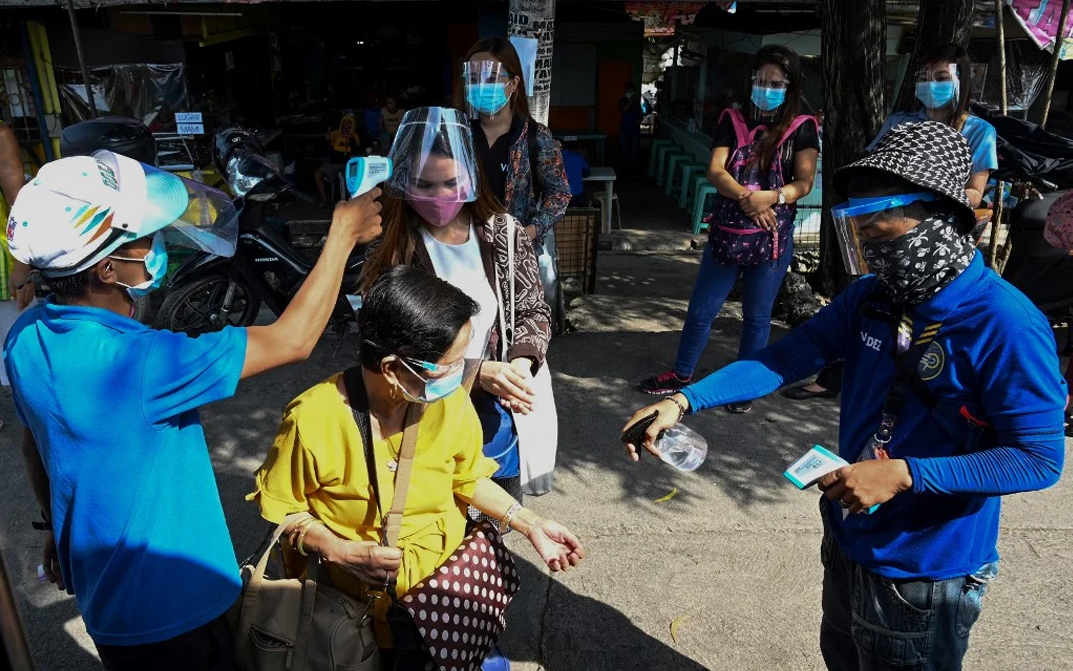
MANILA, Philippines—The COVID-19 rampage in Metro Manila and nearby provinces has reached areas in several regions outside the capital that are now seeing high virus transmission rates, COVID cases, and bed occupancy that are overwhelming their health capacities.
The surge is stretching health facilities beyond their limits in Cagayan Valley, Cebu City, Iligan City, and Sulu province.
Doctors from these four areas shared COVID data to paint a picture of the situation outside Metro Manila, which requires more attention than they are now getting from the public and the national government.
The health experts also expressed the frustrations and aggravations that health workers in those areas are going through.
Numbers as evidence
As described by Dr. Bryan Albert Lim, an infectious disease specialist in Vicente Sotto Memorial Hospital in Cebu City, the COVID-19 pandemic is a “numbers game.”
“It is really a numbers game. The pandemic is really a war on logistics,” Lim said in a Stop COVID Deaths online seminar hosted by the University of the Philippines (UP).
For context, last Sept. 16, the country had 21,261 new cases of COVID 19. This brought the total confirmed cases to 2,304,192 with 177,946 active cases, 2,090,228 recoveries, and 36,018 deaths.
The Cagayan Valley region—which has a total population of 3,693,664—has 88,679 cases with 9,111 active cases, 76,682 recoveries, and 2,676 deaths last Sept. 16.
The region also logged 122 cases of the highly transmissible Delta variant in all of its provinces except Batanes.
“It’s noteworthy that our areas with the outbreak are the four centers of trade, namely Santiago City, Tuguegarao City, Kawayan City, and Ilagan City,” said Dr. Rio Magpantay, director of DOH Cagayan Valley Center for Health Development.
The region, according to Magpantay, also had a high case fatality rate of 3.01 percent and a “shocking” positivity rate of 32.8 percent.
“COVID mortality trend shows that the deaths peaked in the month of August, though it is seen in the graph that it has started to increase in April when local variants of concern have been detected,” Magpantay said.
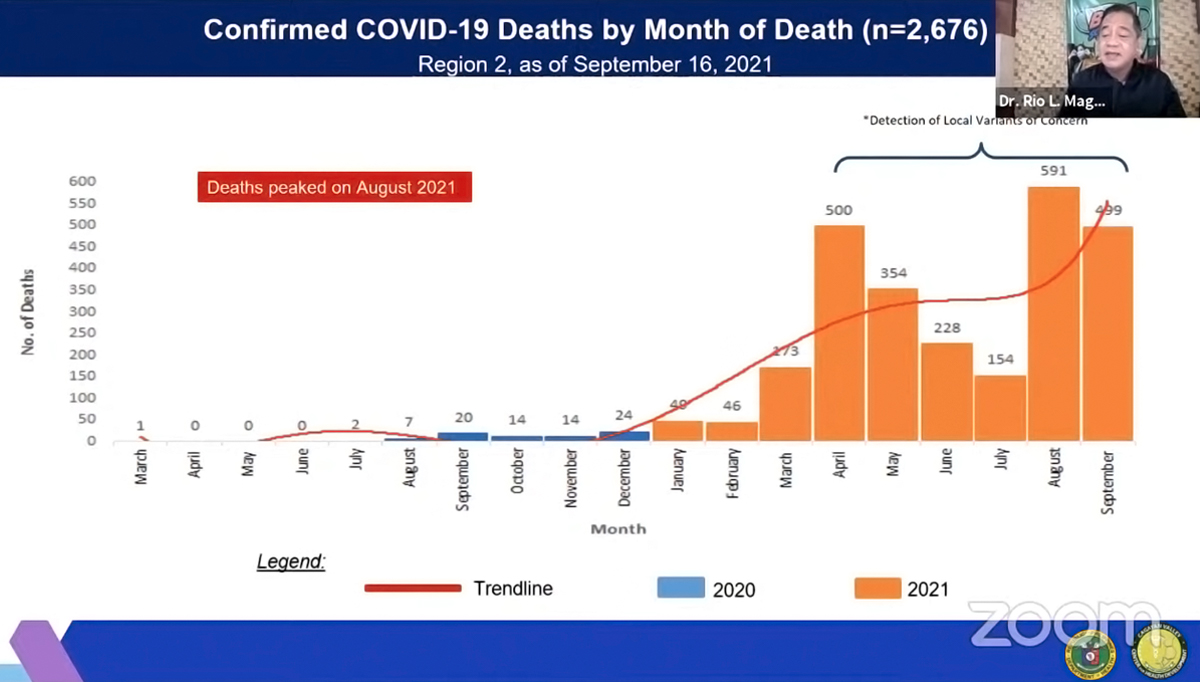
SCREENSHOT. COVID-19 deaths in Cagayan Valley as of September 16. Presented by Dr. Rio Magpantay during the Stop COVID Deaths: COVID-19 Outbreak Sa Probinsya webinar held last September 17, 2021.
“Right now there are many fatalities, [it] is very very sad to hear and see that there are still many cases dying,” he said, speaking partly in Filipino.
Dr. Leonell Albert Quitos, an internal medicine adult infectious disease fellow in Iligan City, said the city is, unfortunately, still “in square one.”
On Sept. 14, the city breached its 1,000 mark for total active cases. On that day, the city’s total number of COVID-19 cases reached 4,291 with 1,014 active cases, 2,961 recoveries, and 316 deaths.
Similar to Cagayan Valley, Iligan City also logged a high case mortality rate.
“Iligan City, I think, has the highest death rate of 7.36 percent. This is way higher compared to the regional death rate, compared to the national and global death rate,” said Quitos.
In Gregorio T. Lluch Memorial Hospital alone, seven patients died on the same day last Sept. 14. Quitos said all of the deceased patients were unvaccinated, despite being classified as belonging to the A2 and A3 vaccination priority groups.
Quitos also noted the high number of “home deaths” in the city. These are COVID-19 patients who were unable to get proper medical attention and died inside their homes.
“Some of them were not catered in hospitals. Some of them refused to go to hospitals because of fear to be labeled as COVID-19 and just prefer to die at home,” he said.
‘Tale of three surges’
Magpantay and Lim showed numbers on the surge of COVID cases in Cagayan Valley and Cebu City.
In Cagayan Valley, according to Lim, the surge coincided with the detection of different variants of SARS Cov2, the virus that causes COVID-19, in the country.
“The peak of cases was seen to have followed the detection of the local variants of concern,” Magpantay said.
“First in March with the detection of Beta and the Alpha variant. Followed by July with the detection of the first case of the Delta variant,” he said.
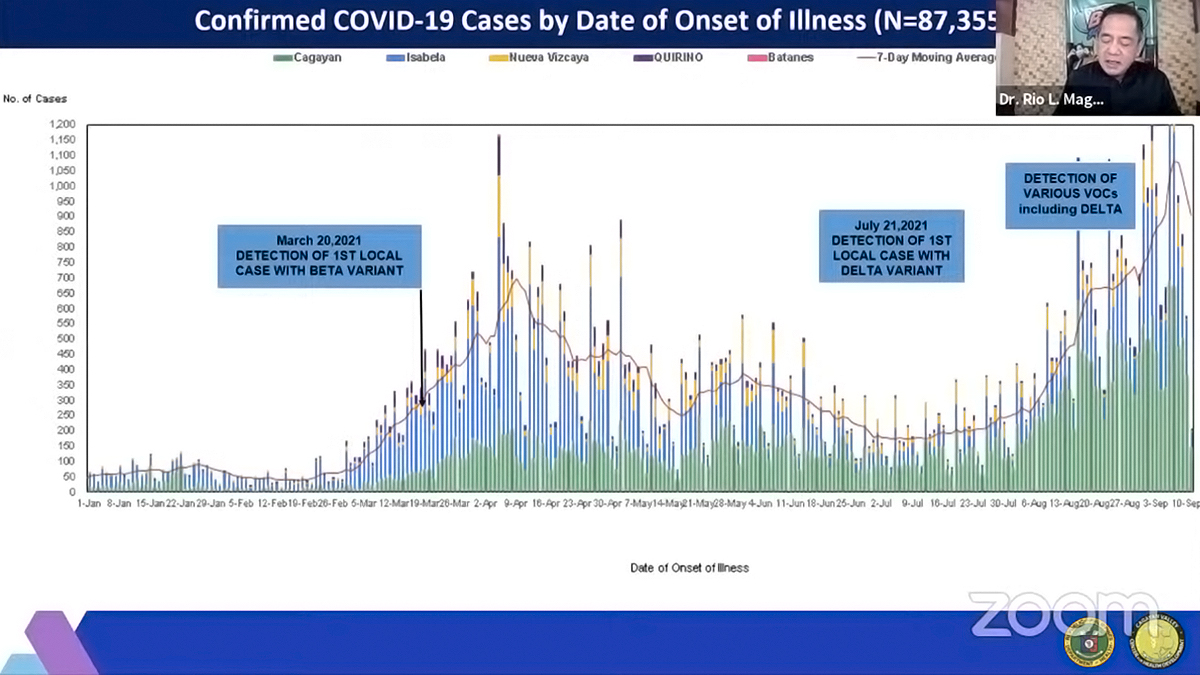
SCREENSHOT. Confirmed COVID-19 cases and surges in Region 2 from 2020 to 2021. Presented during the Stop COVID Deaths: COVID-19 Outbreak Sa Probinsya webinar held last September 17, 2021.
The graph he presented showed a high number of COVID-19 cases in August and September, which the label said was during the detection of various variants, including Delta.
According to Lim, the first two surges in Cebu occurred in August 2020 and in March to April this year.
“The surge last year was the most painful professionally and personally. I lost my dad last August to COVID-19 and I almost lost my mother. During that time many are still clueless,” Lim said.
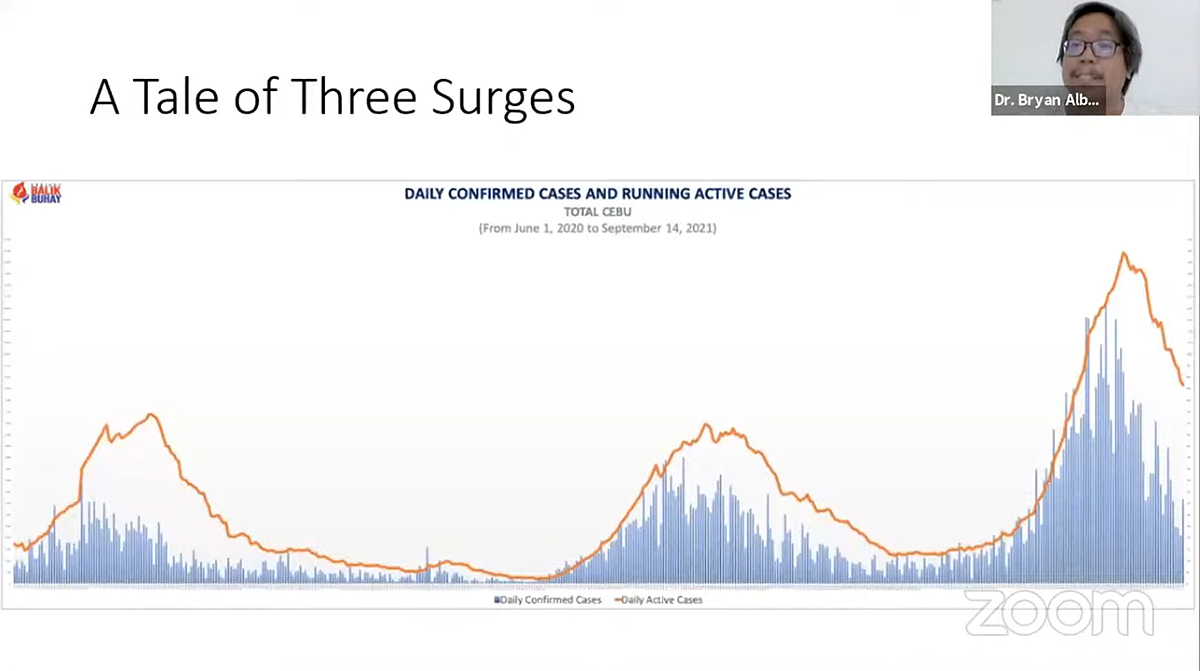
SCREENSHOT. Graph showing the surges in COVID-19 cases in Cebu City, presented by Dr. Bryan Albert Lim during the Stop COVID Deaths: COVID-19 Outbreak Sa Probinsya webinar held last September 17, 2021.
The number of cases “increased because, I have to admit, we let our guard down especially our staff because we thought everything is already getting better,” he said.
Like in Cagayan Valley, Cebu also saw another increase in cases due to the Delta variant.
Still, Lim said that the city is doing much better than during the first two surges.
“Here we are now, we are now in our third surge—Delta-driven surge here in Cebu,” Lim said.
“But I am glad because we are now very apt, our cases slightly decreased. Before our hospital occupancy reaches full capacity but now we are only at 52 percent since the cases are starting to go down,” he added.
He said the city learned a lot after going through those surges. Some of the lessons, according to Lim, were:
- “Long term resiliency requires adaptive learning;
- Humility and sincerity are cornerstones for meaningful collaboration;
- Health system is beyond DOH;
- We are all interdependent;
- Health system needs to radically evolve.”
Hospital utilization
The capacity utilization rate for private hospitals in Cebu City has improved, according to Lim.
From 86.3 percent—or on critical status based on the Department of Health (DOH) classification—in July 2020, the capacity utilization rate went down to a safe status of 58.2 percent last Feb. 22.
Fewer regular and ICU beds allocated for COVID 19 were occupied in February. Moreover, the number of total COVID beds increased from 694 to 794.
However, the number of health care workers assigned to COVID patients decreased from 2,383 last year to 2,072 this year.
The Cagayan Valley region, on the other hand, was placed on high-risk epidemic risk classification. Santiago City, which is an independent city, was given the critical risk status.
According to Magpantay, the region’s overall health capacity utilization rate as of Sept. 16 was 85.98 percent, while the ICU utilization rate was 88.83 percent.
“The entire region is at alert level 4,” said Magpantay.

SCREENSHOT. Epidemic Risk Classification and Health Care Capacity in Region 2. Presented by Dr. Rio Magpantay during the Stop COVID Deaths: COVID-19 Outbreak Sa Probinsya webinar held last September 17, 2021.
Still, he acknowledged the efforts of the local government and private hospitals. According to data provided by Magpantay, the local government and private hospitals allocated COVID beds that exceeded the suggested 50 percent and 30 percent allocation rate.
The situation is even worse in Iligan City.
As of Sept. 16, the city’s bed occupancy rate is on critical status with 94.11 percent—or 128 out of 136 COVID beds occupied.
According to Quitos, there are 453 COVID patients from Iligan City who are currently hospitalized. However, some of these patients were brought to Amai Pakpak Medical Center in Marawi City.
“Our hospitals are catering more than the bed capacity they have allocated,” he said.
The city’s hospitals are also running low in medical equipment, like mechanical ventilators and functional high flow nasal cannula, that are needed for COVID-19 patients.
Out of six hospitals in the city, there are only six mechanical ventilators and 12 functional high-flow nasal cannulas were available for patients.
“How can we cater to a lot of people with just this scarcity of equipment?”
Dr. Fahra Tan-Omar, Sulu Provincial Hospital chief, said that there are only 10 hospitals in the province.
Most were classified as infirmary hospitals while some are just level one hospitals.
“[T]here is no private hospitals [in Sulu],” she said.
According to DOH Memorandum No. 2020-0178—or the Interim Guidelines on Health Care Provider Networks—during the COVID-19 pandemic, the ideal facility for those who are symptomatic, mild, and classified as suspect, probable, or confirmed COVID-19 cases are either temporary treatment monitoring facilities or level one hospitals or infirmaries.
According to Tan-Omar’s data, there are a total of 425 beds allocated for COVID-19 cases among 10 hospitals in Sulu.
The stringent guidelines for travel set by local government units (LGUs) also made it harder for Sulu health workers to properly handle their COVID-19 cases.
“[We] cannot refer to higher centers in Zamboanga City as the LGU does not allow entries,” Tan-Omar shared.
“We manage patients in our own areas including municipal and district hospitals,” she added.
Testing and vaccination
Quitos attributed the high COVID-19 mortality in Iligan City to “under testing” in the locality.
“I asked the institution here in charge of the testing capacity, I asked them regarding the positivity rate, I asked them about the number of samples taken,” he said during his presentation.
“They gave me nothing, they gave me blank template, nothing. I cannot say anything on the testing capacity because this is really reflective of how poor our testing is in our city,” he added.
A molecular lab located in Gregorio T. Lluch Memorial Hospital has been there since December 2020, but is not operational until now.
“This is really sad for us because it’s there,” said Quitos.
“If this is already running maybe we can step up our testing, then we can test early so that we can treat early so that the outcome can be better for the patients,” he said.
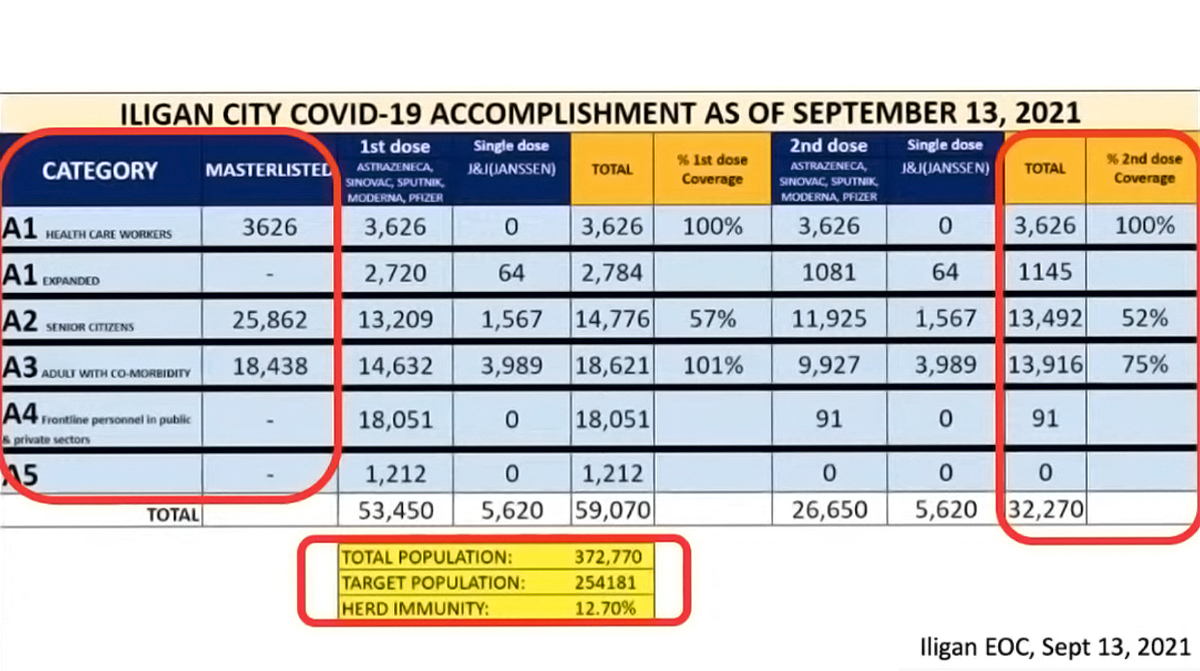
SCREENSHOT. Vaccination statistics of Iligan City as of September 13, 2021. Data presented by Dr. Leonell Albert Quitos during the Leonell Albert Quitos
As of Sept.13, around 59,070 in the city have already received their first vaccine dose while 32,270 are already fully vaccinated against SARS Cov2.
Despite this, the city has vaccinated only 12.70 percent of its target population of 254,181 to achieve herd immunity.
Cagayan Valley, according to Magpantay, also faces challenges in its testing capacity.
The region’s five molecular labs have a testing capacity of 4,422 samples per day. However, the laboratories are located only in Cagayan and Isabela. Some remote areas and province, including Batanes, Quirino, and Nueva Vizcaya, have difficulty or no access to labs.
The region’s COVID challenges also included limited RT-PCR testing kits and rapid Antigen testing kits and shortage of lab workers because of infections.
Cagayan Valley’s vaccine statistics, as of Sept. 16, showed that the region has administered a total of 920,239 vaccine doses. At least 492,609 individuals have received their first doses while 427,630 are already fully vaccinated.
This translates to 16.54 percent of the region’s target population having at least one vaccine dose–around 2,585,565 or 70 percent of the total population.
Long turnaround time was also cited by Tan-Omar as one of the challenges in Sulu in testing.
“We swab suspects admitted at [Zamboanga City Medical Center’s (ZCMC)] OPD and send the specimen by commercial boat,” she said.
“Specimens processed at the ZCMC are free of charge but it takes two to three days before results are released,” she added.
COVID-19 tests in private hospitals and by the Philippine Red Cross, though taking only 24 hours to get results, cost from P2,000 to P3,500 each.
There are 59,912 individuals who are fully vaccinated in the province.
Innovations
Despite the challenges, these areas had some innovations that helped them throughout the pandemic.
To help the overwhelmed health care workers in Cebu City, the city is now hiring nurse assistants who would handle other tasks.
“We made a study on the work of our nurses, as you can really see, 40 to 50 percent of the work of our nurses is not really related to nursing,” Lim said.
“A lot of those is laboratory [tasks], coordinating with the patients’ relatives,” Lim added.
“So we are now hiring nurse assistants so that our nurses will focus on patient care and maximize our health human resources,” he said.
There is also the PBB (Project Balik Buhay) Salbabida Program for health care workers. Under this project, nurses who are assigned to the COVID wing of some private hospitals will receive an additional P15,000 monthly allowance.
“This will not solve really the issue of low wages but I think this is a good example of solidarity and in this pandemic, I think we really have to encourage those acts of kindness,” said Lim.
The city has also established an oxygen production plant, which can produce up to 800 tanks per day.
(This article, written by Cristina Eloisa Baclig, was first published in the Inquirer.NET Website on September 20, 2021)
